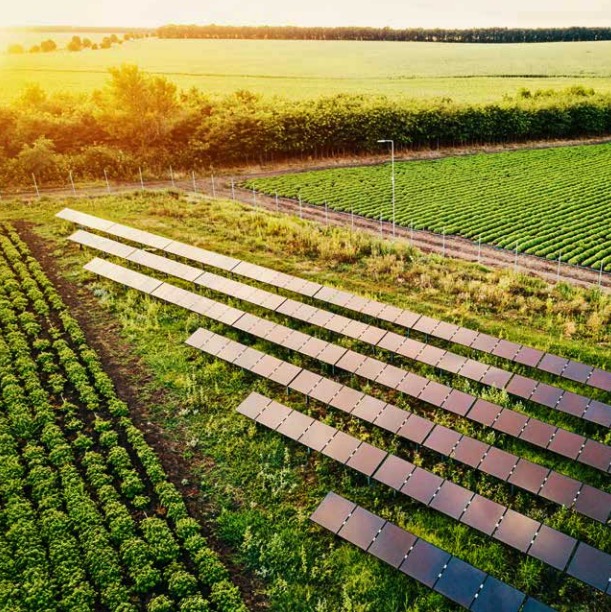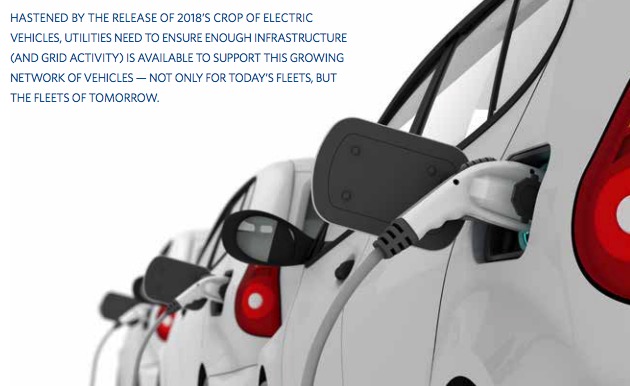BLACK & VEATCH
Executive Summary: The New Energy Economy
By John Chevrette
 The energy ecosystem is changing, driven by the advent of distributed clean energy, increased competition from new technologies and service providers, the evolving expectations of customers, and new opportunities for serving those customers. As the traditional business model changes, utilities are seeking new opportunities for revenue as they establish themselves as the “Preferred Energy Partner.”
The energy ecosystem is changing, driven by the advent of distributed clean energy, increased competition from new technologies and service providers, the evolving expectations of customers, and new opportunities for serving those customers. As the traditional business model changes, utilities are seeking new opportunities for revenue as they establish themselves as the “Preferred Energy Partner.”
But getting there is another story, requiring a comprehensive category of innovative products and services that will define the future of revenue generation in the energy space. Today, opportunities appear limitless, enabled by renewable technologies, enhanced connectivity behind/beyond the meter, and mobile-optimized products and services.
The questions that electric utilities should ask themselves are not new, but they are taking on a heightened sense of impact as utilities enter a more competitive retail market:
- Do you have a clear roadmap for how your organization will grow earnings?
- What is your strategy for addressing potential competition?
- What are your existing market solutions lacking?
- Is your organization well-positioned to explore new/alternative business models?
- What value does your organization put on innovation?
The answers are complex and multifaceted. Reliability and resilience still are the cornerstones of the industry and top of mind for all customer classes. Natural disasters regularly serve as compelling events and constant reminders of how delicate our critical infrastructure can be — not to mention the security-based risk, both cyber and physical that are constantly in the back of all our minds — in this hyper-connected world we live in.
There isn’t a technology “silver bullet” to remedy what the power industry is facing, but as traditional infrastructure is replaced or hardened and the Internet of Things (IoT) solutions residing at grid edge becomes closer to scalable reality, a final consideration tempers the pace of change – cost.
The balance, or tug of war, between highly reliable service and innovation products (that are cost-effective and perceived as high value by both customers and regulators) is an ever-present reality for both investor-owned and municipal utilities. No one wants to see their electric bill increase, and many customers make rational decisions to install solar and batteries, and to participate in demand-side management or energy efficiency programs to mitigate these costs.
But as more customers move toward adopting distributed generation, the issue of who should bear the cost of maintaining central generation, transmission and distribution becomes an even greater debate. Most customers still rely on a traditional utility to serve at least a portion of their daily energy demand, and nearly all require their utility to serve as a provider of last resort.
This means very little critical infrastructure can truly be retired — quite the opposite really. As more advanced and emerging technology comes online, the grid must evolve to handle the changing load conditions with a level of intelligence not expected even a decade ago. This means that utility and regulators must work together to design the following rate structures that reward and mirror the cost associated with the time of demand: fixed charges that fairly reflect the level of service a customer requires; and incentives to support customers’ sustainability goals.
But the trick is to accomplish this without shifting undue burden to the utility, which relies heavily on the utility’s ability to change the very core of its business, becoming an agile market operator rather a highly regulated monopoly.
These themes, and many more, are explored in this year’s report.
The concept of “new energy” has ushered in a global movement dedicated to clean energy technology and innovation. Today more than ever, we’re seeing experts from all sectors — academia, finance, corporations, utilities and tech incubators — come together in combined efforts. Rapid change is afoot in the marketplace, grid systems and business models, raising the question: What does the future hold?
Integrating Renewables
Utilities increasingly are turning to solar and wind to generate power, but concerns linger over the potential for renewable energy sources, with their inherent uncertainty and variability, to adversely impact today’s grid. Just a few years ago, the industry predicted that the grid could handle only 30 percent of its power from renewables; today, we’re seeing integration on a much larger scale.
Grid Mod Progresses, but Gaps Remain
Transitioning traditional networks to a smarter grid has been going on for a long time, but the last five years have seen the industry really crank up its investment in grid modernization efforts. Buoyed by data showing the reliability of automation and the operational efficiency of smart grids, states with formal programs increasingly are giving utilities the green light to advance while providing blueprints for other regions to follow suit.
Non-Traditional Clients Impact the Grid
Maturing technologies and a growing emphasis on energy efficiency and sustainability are leading organizations to manage more distributed energy resources (DER) than in the past. Armed with more flexibility behind the meter, companies are becoming increasingly energy independent, with industrial parks, colleges and universities, hospitals, military installations and government facilities becoming the most common applications for DER.
Microgrids Enable Distributed Energy Resources
The growth of DER and microgrids continues to improve energy-supply scenarios for data centers, military installations and disasterrelief operations, and other industries such as airports and schools are taking note. Fueled by an enthusiasm for energy cost savings, sustainability, reliability and resilience, the market has never been more robust or ready to embrace these new technologies.
Energy Storage and Natural Gas
The cost of energy storage has fallen to the point where the power generation industry is moving from pilot projects to full deployment. Driven by demand and a recent Federal Energy Regulatory Commission (FERC) order designed to integrate storage into the power market, new scenarios are emerging that pair storage with conventional gas turbine generation to improve performance. In a way, gas turbines and renewables are beginning to solve each other’s problems.
Energy Storage Electrifies Renewables
Energy storage technology has been advancing for decades, backed by a growing awareness that storage holds the key to unlocking the world’s energy future. As storage technology makes strides toward integrating electricity from any source into a more resilient and reliable grid, we are growing closer to fully understanding the potential of storage to radically transform energy markets. Today, energy storage is proven and ready for business.
Utilities Work to Integrate Electric Vehicles
Last year saw utilities in planning mode as they worked to better understand aggregated charging; this year, utilities are putting those plans into practice as they launch pilot programs. Hastened by the release of 2018’s crop of electric vehicles (EVs), utilities need to ensure enough infrastructure (and grid activity) is available to support this growing network of vehicles — not only for today’s fleets, but the fleets of tomorrow. From planning for increased load and charging, to taking steps to harmonize this need with grid operations, utilities have a long road ahead of them.
The New Power Grid Power
delivery has undergone significant change over the past 40 years, but no shift will be greater than the one that lies before us. While the obligation to deliver power to customers in a safe, reliable fashion is as important today as it was a century ago, there is little resemblance to how those goals will be achieved. Utilities now face the realities of new players, new access to generation for consumers and ever-aging infrastructure. The era of change is upon us.
A New Approach to Capital
Historically, capital allocation has focused primarily on replacing aging infrastructure. Today, the game has changed, from the partial and unpredictable generation of DER to the influx of new technologies such as microgrids, EVs and energy storage. On the governmental and regulatory front, states are making momentous decisions that will significantly impact how utilities operate. This type of market disruption is forcing utilities to apply new thinking and address capital differently.
Combined Heat and Power Offers Opportunity
The benefits of combined heat and power (CHP) are known, and the technology is recognized as having great potential to dramatically increase American electricity generating capacity. Aside from helping to achieve national energy requirements, CHP has emerged as an important potential component of well-designed microgrids, providing local grid security and resiliency in the event of catastrophic power outages.
Construction Gets Innovative
Once famously slow to embrace technology, electric utilities are awakening to the power of innovation, from deploying drones to relying on robotics and implementing outside-the-box construction practices. As technology continues to reign supreme, with the shift to decentralized, digital grids and the broadening appeal of increasingly affordable solar power systems, power suppliers no longer have the luxury of resisting change.
Conclusion
Plunging costs of solar power and growing concerns of climate change are inspiring ranks of the largest private and Fortune 500 companies to pursue aggressive renewable energy goals for sustainability, cost effectiveness and resiliency. This has left utilities with the sobering question of whether to significantly invest in green infrastructure to keep these large customers or watch large, rate-paying customers defect, taking considerable revenues with them.
In this industry, which has long been viewed as moving at a glacial pace, such pressures should be a pressing clarion call for engagement between utilities and the regulators whose constructs often lag behind advances in technology and customer expectations.
Download full report (PDF): 2018 Strategic Directions – Electric Report
About Black & Veatch
bv.com
Black & Veatch started 1915 as a two-person partnership between former University of Kansas classmates Ernest Bateman Black and Nathan Thomas Veatch. The company began with 12 employees with offices in Kansas City, Missouri. It landed two large contracts, one in power and one in water, in its first year…Today, the company continues to experience strong growth across its core markets. Black & Veatch currently has a global workforce of more than 9,000 working in over 100 offices worldwide with projects completed in more than 100 countries on six continents.
Tags: Black & Veatch, electric grid, Electricity







 RSS Feed
RSS Feed